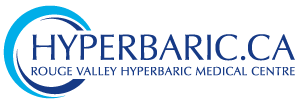What conditions are cured/improved with HBOT?
Health Canada recognizes Hyperbaric Oxygen Therapy for following acute and chronic conditions:
- Embolisms (air or gas bubbles in the bloodstream, which may travel to the brain or lungs)
- Carbon monoxide poisoning (from inhaling smoke or car exhaust)
- Gas gangrene
- Crush injury, Compartment Syndrome and other acute traumatic problems where blood flow is reduced or cut off (e.g., frostbite)
- Decompression sickness (the bends);
- Enhancement of healing for wounds such as diabetic foot ulcers
- Exceptional blood loss (anemia);
- Intracranial abscess (an accumulation of pus in the brain)
- Necrotizing soft tissue infections (flesh-eating disease);
- Osteomyelitis (bone infection)
- Delayed radiation injury (e.g., radiation burns that develop after cancer therapy, radiation cystitis, proctitis)
- Skin grafts and flaps that are not healing well
- Thermal burns (e.g., from fire or electrical sources)
- Sudden Idiophatic Sensory-neural Hearing Loss
- Acute central retinal artery occlusion
For some of the conditions such as embolism, carbon monoxide poisoning and decompression sickness, hyperbaric oxygen therapy the principal and definitive treatment. For others such as bone infection, chronic wounds, compromised skin and graft support, and intracranial abscess, HBOT is an effective and very important adjunct in a combined with programs involving antibiotics, dressing changes and surgery for the enhancement of healing. All indications recognized by Health Canada are covered by OHIP.
Research studies have found improvements after hyperbaric oxygen therapy in some neurological conditions such as stroke, concussion, traumatic brain injury, chronic pain (fibromyalgia, pain related to nerve injury, migraines and cluster headaches, interstitial cystitis, trigeminal neuralgia) and selected sport injuries.
Hyperbaric oxygen treatment for these conditions are not covered by OHIP
